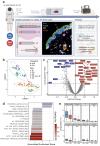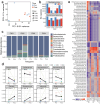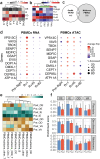Spatial multi-omics of human skin reveals KRAS and inflammatory responses to spaceflight
- PMID: 38862494
- PMCID: PMC11166909
- DOI: 10.1038/s41467-024-48625-2
Spatial multi-omics of human skin reveals KRAS and inflammatory responses to spaceflight
Abstract
Spaceflight can change metabolic, immunological, and biological homeostasis and cause skin rashes and irritation, yet the molecular basis remains unclear. To investigate the impact of short-duration spaceflight on the skin, we conducted skin biopsies on the Inspiration4 crew members before (L-44) and after (R + 1) flight. Leveraging multi-omics assays including GeoMx™ Digital Spatial Profiler, single-cell RNA/ATAC-seq, and metagenomics/metatranscriptomics, we assessed spatial gene expressions and associated microbial and immune changes across 95 skin regions in four compartments: outer epidermis, inner epidermis, outer dermis, and vasculature. Post-flight samples showed significant up-regulation of genes related to inflammation and KRAS signaling across all skin regions. These spaceflight-associated changes mapped to specific cellular responses, including altered interferon responses, DNA damage, epithelial barrier disruptions, T-cell migration, and hindered regeneration were located primarily in outer tissue compartments. We also linked epithelial disruption to microbial shifts in skin swab and immune cell activity to PBMC single-cell data from the same crew and timepoints. Our findings present the inaugural collection and examination of astronaut skin, offering insights for future space missions and response countermeasures.
© 2024. The Author(s).
Conflict of interest statement
C.E.M. is a scientific advisor of NanoString Inc. A.R., B.M.H., and S.E.C. are employees of NanoString Technologies, and J.M. and S.M. are employees of SpaceX. The remaining authors declare no competing or relevant interests.
Figures





Similar articles
-
The Space Omics and Medical Atlas (SOMA) and international astronaut biobank.Nature. 2024 Aug;632(8027):1145-1154. doi: 10.1038/s41586-024-07639-y. Epub 2024 Jun 11. Nature. 2024. PMID: 38862028 Free PMC article.
-
Prevalence of sleep deficiency and use of hypnotic drugs in astronauts before, during, and after spaceflight: an observational study.Lancet Neurol. 2014 Sep;13(9):904-12. doi: 10.1016/S1474-4422(14)70122-X. Epub 2014 Aug 7. Lancet Neurol. 2014. PMID: 25127232 Free PMC article.
-
Collection of biospecimens from the inspiration4 mission establishes the standards for the space omics and medical atlas (SOMA).Nat Commun. 2024 Jun 11;15(1):4964. doi: 10.1038/s41467-024-48806-z. Nat Commun. 2024. PMID: 38862509 Free PMC article.
-
Contemporary review of dermatologic conditions in space flight and future implications for long-duration exploration missions.Life Sci Space Res (Amst). 2023 Feb;36:147-156. doi: 10.1016/j.lssr.2022.10.004. Epub 2022 Oct 13. Life Sci Space Res (Amst). 2023. PMID: 36682824 Review.
-
Effects of Spaceflight on Human Skin.Skin Pharmacol Physiol. 2021;34(5):239-245. doi: 10.1159/000515963. Epub 2021 May 31. Skin Pharmacol Physiol. 2021. PMID: 34058745 Review.
Cited by
-
Chemical Tomography of Cancer Organoids and Cyto-Proteo-Genomic Development Stages Through Chemical Communication Signals.Adv Mater. 2025 Mar;37(12):e2413017. doi: 10.1002/adma.202413017. Epub 2025 Feb 11. Adv Mater. 2025. PMID: 39935131 Free PMC article.
-
A second space age spanning omics, platforms and medicine across orbits.Nature. 2024 Aug;632(8027):995-1008. doi: 10.1038/s41586-024-07586-8. Epub 2024 Jun 11. Nature. 2024. PMID: 38862027 Free PMC article. Review.
-
More than a Feeling: Dermatological Changes Impacted by Spaceflight.Res Sq [Preprint]. 2023 Feb 10:rs.3.rs-2367727. doi: 10.21203/rs.3.rs-2367727/v1. Res Sq. 2023. Update in: Commun Med (Lond). 2024 Jun 11;4(1):106. doi: 10.1038/s43856-024-00532-9. PMID: 36798347 Free PMC article. Updated. Preprint.
-
Aging and putative frailty biomarkers are altered by spaceflight.Sci Rep. 2024 Jun 11;14(1):13098. doi: 10.1038/s41598-024-57948-5. Sci Rep. 2024. PMID: 38862573 Free PMC article.
-
Protective alleles and precision healthcare in crewed spaceflight.Nat Commun. 2024 Jul 22;15(1):6158. doi: 10.1038/s41467-024-49423-6. Nat Commun. 2024. PMID: 39039045 Free PMC article. Review.
References
-
- Clément, G. Fundamentals of Space Medicine (Springer, 2011).
MeSH terms
Substances
Grants and funding
LinkOut - more resources
Full Text Sources
Miscellaneous

